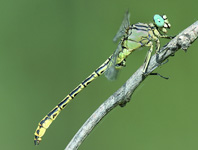Abstract
Gomphus kinzelbachi was described by Wolfgang Schneider (1984) on the basis of a single teneral male captured by B. L. Sage on the Alwand River in eastern Iraq. In late April to early May 2016 two of the authors (TS and DI) discovered three individual-rich populations of this species on the large lowland river Karkeh in southwestern Iran (Khuzestãn). This is the first report of a breeding population of this species. Based on collected material we confirmed the structural differences of the male secondary genitalia between G. kinzelbachi and G. davidi on a larger number of animals. The female of the species is described. Gomphus kinzelbachi resembles most closely G. davidi, compared to all other West-Palearctic Gomphus species. Therefore, a direct comparison of the two species is given, and additionally some differential diagnostic hints for two other Gomphus species reported from Iran is provided. Our observations suggest that G. kinzelbachi reproduces on large clean lowland rivers in SE Iraq and SW Iran. In SW Iran only a free flowing stretch of the Karkeh, one of three parallel rivers (Karkeh, Karoon, Dez), seems to be suitable for this species. The other two rivers are affected by dams, dam construction, and increasing salinization. Additional dam constructions are also planned on the Karkeh River, thus, G. kinzelbachi may be on the brink of extinction.
References
Afkhami, M. (2003) Environmental effects of salinity in the Karun-Dez basin, Iran. Seventh International Water Technology Conference Egypt, 1–3 April 2003.
Asahina, S. (1973) The odonata of Iraq. Japanese Journal of Zoology, 17, 17–36.
Boudot, J.-P., Kalkman, V.J., Amorin, M.A., Bogdanovic, T., Rivera, A.C., Degabriele, C. , Dommanget, J.-L. , Ferreira, S. , Garrigos, B., Jovic, M. , Kotarac, M., Lopau, W., Marinov, M., Mihokovic, N., Riservato, E., Samraoui, B. & Schneider, W. (2009) Atlas of the Odonata of the Mediterranean and North Africa. Libellula Supplement, 9, 1–256.
Boudot, J.-P. & Kalkman, V.J. (2014) Chapter 5. Odonata (dragonflies and damselflies). In: Smith, K.G., Barrios, V., Darwall, W.R.T. & Numa, C. (Eds.), The status and distribution of freshwater biodiversity in the Eastern Mediterranean. IUCN, Cambridge, pp. 55–67.
Dia, A. & Dumont, H.J. (2011) The Odonata of Lebanon. Zoology in the Middle East, 52, 63–70.
https://doi.org/10.1080/09397140.2011.10638480Dumont, H.J. (1991) Fauna Palaestina. Insecta V - Odonata of the Levant. Genus Gomphus. The Israel Academy of Sciences and Humanities, Jerusalem, pp. 126–138
Hosseini-Zare, N., Gholami, A., Panahpour, E. & Jafarnejadi, A. (2014) Pollution Load Assessment in the Soil and Water Resources: A Case Study in Karun River Drainage Basin, Southwest of Iran. European Online Journal of Natural and Social Sciences, Vol.3, No.3 Special Issue on Environmental, Agricultural, and Energy Science, 3, pp. 427–434. Avaliable from: http://european-science.com/eojnss/article/view/2669 (Accessed 10 Jan. 2017)
IUCN (2016) The IUCN Red List of Threatened Species, 2015.4. International Union for Conservation of Nature and Natural Resources. Available from: http://www.iucnredlist.org/ (Accessed 19 May 2016)
Kalkman, V.J., van Pelt, G.J., Dumont, H. J., Yu Haritov, A. & Tailly, M. (2004) Critical species of Odonata in Turkey, Iran and the Caucasus. International Journal of Odonatology, 7, 325 ̶ 339.
https://doi.org/10.1080/13887890.2004.9748220Kalkman, V.J. (2006) Gomphus kinzelbachi. The IUCN Red List of Threatened Species 2006:e.T59719A11997702.
https://doi.org/10.2305/IUCN.UK.2006.RLTS.T59719A11997702.en
Lohmann, H. (1992) Gomphus kinzelbachi Schneider in Iran (Anisoptera:Gomphidae). Notulae odonatologicae, 3, 1–169.
Mansournejad, M., Kalantari, B., Mahdavi, M. & Adeli, M. (2015) The Investigation of Negative Effects of Salt Dome on the Quality of Water in Gotvand Olya Dam and the Use of Cut-off)Wall as Treatment. American Journal of Civil Engineering. Special Issue: Research and Practices of Civil Engineering in Developing Countries, 3, pp. 53–56.
Martin, R. (1912) Les odonates. In: de Morgan, J. (editor), Annales d´ Histoire Naturelle, Delegation en Perse, Tome III Entomologie, Ernest Leroux, Paris, 2, 5–9.
Sage, B.L. (1960) Notes on the Odonata of Iraq. Entomologist, 93, 118–125.
Sadeghi, S. & Mohammadalizadeh, J. (2009) Additions to the Odonata fauna of Iran. Iranian Journal of Science & Technology, Transaction A, 33, 355–359.
Schmidt, E. (1953) Zwei neue Libellen aus dem Nahen Osten. Mitteilungen der Münchner Entomologischen Gesellschaft, 43, 1–9.
Schmidt, E. (1954) Die Libellen Irans. Sitzungsbe-richte der österreichischen Akademie der Wissenschaften, Wien, Kl. 1, 163, 223–260.
Smith, K.G., Barrios, V., Darwall, W.R.T. & Numa, C. (Eds.) (2014) The status and distribution of freshwater biodiversity in the Eastern Mediterranean, Cambridge, UK, Malaga, Spain and Gland, Switzerland, IUCN. xiv+132pp.
Schneider, W. (1984) Beschreibung von Gomphus kinzelbachi n. sp. aus dem Iraq (Odonata: Anisoptera: Gomphidae), Entomologische Zeitschrift, 94, 1–16.
Schneider, T. & Schneider, J. (2010) Occurence, behaviour, and habitat preference of the Levant Pincertail, Onychogomphus macrodon Selys, 1887 in Turkey. Zoology in the Middle East, 49, 79–88.
https://doi.org/10.1080/09397140.2010.10638393Schneider, T., Schneider, J. & Seidenbusch, R. (2013) Odonata of North-Israel with a focus on the Upper Jordan Valley (Upper Galilee) – an update and a comparison between observations a quarter of a century (Odonata). Entomologische Zeitschrift, 123, 129–134.
Schwartzstein, P. (2015) Iraq's Famed Marshes Are Disappearing—Again, http://news.nationalgeographic.com/2015/07/150709-iraq-marsh-arabs-middle-east-water-environment-world/
St. Quentin, D. (1964) Odonaten aus Anatolien und dem Irak. Entomologische Mitteilungen aus dem Zoologischen Museum Hamburg, 50, 49–51.
Suhling, F. & Müller, O. (2006) Gomphus. In: Dijkstra, K.-D.B. & R Lewington, R. (Eds.), Field guide to the dragonflies of Britain and Europe, British Wildlife Publishing, Gillingham, pp. 180–193.
The Guardian (2015) How Iran's Khuzestãn went from wetland to wasteland. Avaliable from: http://www.theguardian.com/world/iran-blog/2015/apr/16/iran-Khuzestãn-environment-wetlands-dust-pollution (Accessed 30 May 2016)
van´t Bosch (2010) All Odonata. Avaible from: http://www.allodonata.com/?q=Gomphus%20davidi&Continent=1&OB=-2 (Accessed 1 July 2016)

